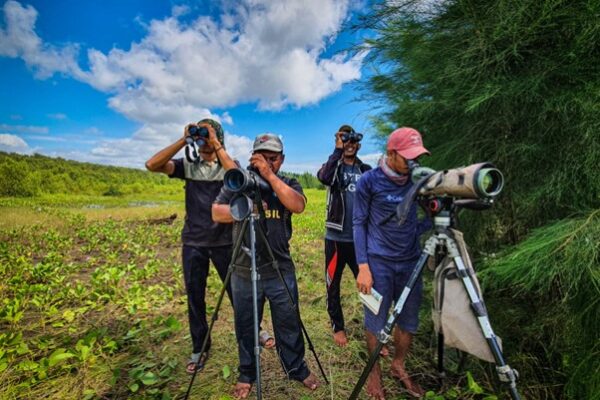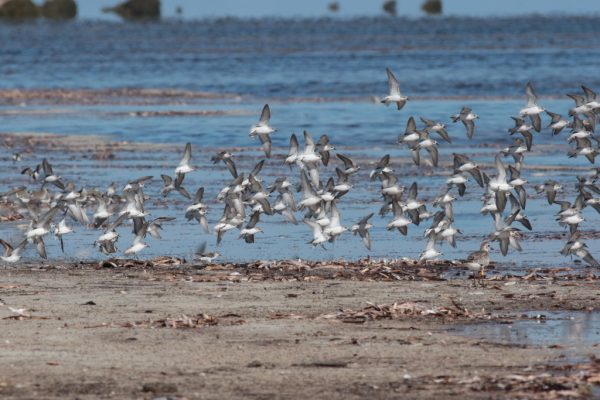-
Activities of the EAAFP Secretariat for Hwaseong Wetlands Conservation Projects 2020-2022
The scenery of the Hwaseong Wetlands Flyway Network Site © EAAFP Secretariat In November 2018, Hwaseong Wetlands was nominated as the East Asian-Australasian Flyway Network Site (FNS) as its importance as a habitat for migratory waterbirds has been acknowledged. With its designation, Hwaseong City and the EAAFP Secretariat signed an MOU [article] and proceeded with the project called “Collaboration for Conservation of the Hwaseong Wetlands” for three consecutive years, from 2020 to 2022. This article demonstrates the project activities that were carried out in chronological order. <2020> The Project was carried out in six major activities. EAAFP, Birds Korea, Federation for Environmental Movements of Hwaseong (KFEM Hwaseong), Korea Federation for Environmental Movements (KFEM), and Hwaseong City together prepared for the event from June, proceeding with the international symposium online in December 2020. About 300 concurrent users with 2400 views participated and discussed the management of Hwaseong Wetlands together with citizens, farmers, fishermen, the Rural Community Corporation, the Ministry of Oceans and Fisheries, the Ministry of Environment, researchers, international organizations, and overseas experts. Article: Link Follow-up Actions to the Symposium: Production of Guidelines for Hwaseong Wetland Management Plan and Workshops. Based on discussions on the management of Hwaseong Wetlands at the symposium in December 2020, the EAAFP Secretariat presented guidelines for Hwaseong Wetland Management Plan after two workshops and one advisory meeting in February and March 2021. Hwaseong City, Hwaseong Eco Foundation, and the Symposium Task Force team (the EAAFP Secretariat, KFEM, KFEM Hwaseong, and Birds Korea) participated in the workshop to reach an agreement on the direction of Hwaseong Wetland management in 2021 and beyond. The title of the guideline is ‘The Proposal for the Management Directions for the Sustainable use of the Hwaseong Wetlands’ and was referred to domestic and international wetland management plans and management guidelines. This suggestion presents the scope of management, direction of wetland management, partnership establishment, and setting of goals and implementations. It also proposes to form a consultative body when establishing a partnership, to have an implementation organization accordingly, and to entrust it to civic groups, which has not been attempted in Korea. The authors of the guidelines are Ms. Yeonah Ku (EAAFP Secretariat), (KFEM Hwaseong), and Ms. Hyeseon Do (EAAFP Secretariat), members of the Symposium TF. The external manuscript of Han Donguk, the Director of the PGA Wetland Ecology Research Institute, was also included. Article: Link Hwaseong Wetlands Conservation Resident Project The resident project organized by HEFM initially considered the formation of a symposium preparatory committee, but because of the rising number of COVID-19 cases, it was more carried out as an awareness-raising-oriented activity. From July 2020 to March 2021, six meetings, seven campaigns, eight club activities, two discussions, three lectures, five civic ecological research group activities, and one ecological exploration activity were held. Article: Link International Cooperation Project for the Conservation of Far Eastern Curlew The EAAFP Secretariat discussed with EAAFP Far Eastern Curlew Task Force and decided to support the “Far Eastern Curlew Conservation Project in Sumatra Island” and funded the EKSAI Foundation in Indonesia. Through this research, a full investigation of Far Eastern Curlew and waterbirds in northern Sumatra including Sembilang National Park (South Sumatra Province), Pantai Cemara (Jambi Province) and Bagan Serdang (North Sumatra Province) was made, and training was conducted to local guards. Moreover, a report that compares and analyzes with waterbirds data has been written, which is uploaded on the EAAFP website. Article: Link Waterbird-oriented Ecological Survey and Far Eastern Curlew Network Construction Project Organized by Birds Korea and KFEM, ecological surveys at the Hwaseong Wetlands were carried out from June 2020 to March 2021. Through the survey, migration behavior and habitat of migratory waterbirds and their juvenile were identified. Based on the findings, guideline directions were proposed, and the Far Eastern Curlew Network was formed in December 2020. Among the findings, a report written in 2020 is uploaded on the EAAFP website. Related article 1: “Flyway: connecting people and migratory waterbirds” story series #6– Interview with Dr. Nial Moores Related article 2: The Hwaseong Wetlands Project Related article 3: The Launch of Far Eastern Curlew Network of the Korean Peninsula Promotional and Educational Materials Production Project The EAAFP Secretariat produced key species factsheets for public-raise awareness purposes in the East-Asian Australasian Flyway. The nine species were produced in both Korean and English. Article: Link Moreover, EAAFP Secretariat operated Hwaseong Wetlands FNS Facebook from July 2020 and is promoting Hwaseong Wetlands conservation activities. Article: Link Furthermore, prizes for the Hwaseong Wetland Promotion Contest winner were delivered. [Prize-winner] <2021> The Project was carried out in four major activities. International Cooperation Project for the Conservation of Far Eastern Curlew Following the previous activity of the Far Eastern Curlew surveys in Sumatra in Indonesia, the EKSAI Foundation took another series of surveys as well as training local communities in Sumatra. See the results and the reports in the separate article: Link Local Cooperation Project: Far Eastern Curlew Network in the Korean Peninsula Following the suggestion from the EAAFP Secretariat and Birds Korea in 2020 based on the ecological survey in the Hwaseong Wetlands Flyway Network Site (FNS) in 2020 and existing data from the National Institute of Biological Resources (NIBR), three local governments in ROK, Hwaseong City, Seocheon County, Yeonsu District of Incheon City, initiated the Far Eastern Curlew Network in the Korean Peninsula since 1st December 2020. As a secretariat of the network, Hwaseong City supported the Far Eastern Curlew survey held in July 2021, following the advice of Birds Korea and the EAAFP Secretariat. From July 21st to 25th 2021, 26 survey participants counted Far Eastern Curlews and other species at 34 sites in three areas: parts of coastal Incheon (Ganghwa Island, Yeongjong Island and Songdo, the Han Estuary); the adjacent Gyeonggi Coast (the Hwaseong Wetlands and Asan Bay); and the Geum Estuary (Figure 1). Participants are experienced counters with specialist knowledge of their areas. A total of 9,642 Far Eastern Curlews were recorded with 3,746 in Incheon; 3,255 in parts of Gyeonggi mainland coast; and 2,641 in Geum Estuary. This is around a third of the world’s population of the species, which was estimated to be 32,000 individuals (range: 20,000 – 49,000 individuals, source: https://www.iucnredlist.org/) Article: Link Local Residents Support Project: Citizen Ecological Survey, Marine Waste Cleaning, Civic Forum, and Walking Event To promote the importance of the Hwaseong Wetlands and to conserve wetlands in the hands of the local people, the EAAFP Secretariat and the Korean Federation of Environmental Movement–Hwaseong (KFEM Hwaseong) implemented the Local Residents Project for Conservation of the Hwaseong Wetlands from April to December 2021. Through the Project a citizen-based ecological survey group was formed, and ecological surveys and on-site monitoring activities were conducted with the guide led by experts in waterbirds, large benthos, wild animals, and amphibians. The Youth at Durae Natural High School near the Hwaseong Wetlands and instructors working in the region formed a small group (Dingo Club) together and conducted 5 times of indoor and field education activities regarding the Hwseong Wetlands. The students participated in the “Hwaseong Youth Policy Proposal Contest” and proposed policies for establishing the “Hwaseong Wetland Education Center” and won the Excellence Award. A local birdwatching and marine waste cleaning events were also held for the local citizens, providing sufficient education regarding marine waste problems and the importance of waterbirds. Furthermore, A civic forum was held with wetland NGOs, experts, and residents, titled ‘Benefits of the Hwaseong Wetlands, Shared with Together.’ Through the Forum, it was an opportunity to resolve conflicts over wetland development & conservation, seek new directions for reclaimed land in the Hwaseong Wetlands, and emphasize the importance of the Hwaseong Wetlands in and outside Hwaseong City. Lastly, Hwaseong Wetland Citizens’ Walking Event: Life and Peace Road was organized in solidarity with 17 civil society organizations in Suwon and Hwaseong Cities. Walking along the 5km section of the Hwaseong seawall, citizens toured the Hwaseong Wetlands, where numerous lives are alive and breathing, and shared the meaning of peace by listening to the story of the village suffering from 54 years of combat airfield at Maehyang-ri History Hall. Article: Link 2021 International Symposium for the Hwaseong Wetlands – “All Connected through the Hwaseong Wetlands: One World, One Future” On 26th November, the 2021 International Symposium for the Hwaseong Wetlands hosted by Hwaseong City took place at Purmir Hotel, Hwaseong City. Hwaseong Eco Foundation, EAAFP Secretariat, Birds Korea, and Korea Federation for Environmental Movements (KFEM) of Hwaseong co-organized the event, with support from the Ministry of Environment Ministry of Oceans and Fisheries, Cultural Heritage Administration of the Republic of Korea, and Hanns Seidel Foundation Korea. Based on the ideas drawn from the forum, the speakers raised the management and restoration plan on Tidal Flats in ROK with a policy proposal and discussed how to join force for the UNESCO World Natural Heritage Site Phase II. In addition, international experts presented the importance of designating the inland wetlands along the Hwaseong Lake as a Wetland Protected Area and the future management guidelines of the Hwaseong Wetlands with moderation by, Ms. Choony Kim, Secretary General of KFEM. During the panel discussion, the panelists emphasized the importance of designating the inland wetlands along the Hwaseong Lake as a Wetland Protected Area and the future management guideline of the Hwaseong Wetlands. Article: Link Symposium Video Links: Korean, English <2022> The Project was carried out in four major activities. International Cooperation Project for the Conservation of Far Eastern Curlew & domestic cooperation The afterwork has been conducted for the Far Eastern Curlew Conservation Project in Sumatra, Indonesia from January and February. The report document was revised according to the updated information provided by the EKSAI Foundation, the leading organization of the Fare Eastern Curlew Conservation Project in Sumatra. FEC Survey has been conducted in the Philippines from October to December 2022. The surveys were conducted in Bulacan, Malolos City, Pamarawan; National Capital region, Navotas City, Tansa; Cebu, Mandaue City; Negros Island, Negros Occidental; Iloilo City, Iloilo Province; Masbate State, Bicol Region; Oriental Mindoro; and La Union. With this survey there was an opportunity to introduce potentially important habitats for FEC in the Philippines and share survey data. It was reported that further support is required for the continuous implementation of the survey. In the other hand, the Secretariat supported the Hwaeong Eco Foundation and Hwaseong City by holding several meetings/ participating in several education trainings as a domestic cooperation activity. Hwaseong Wetlands Visioning Project In consultation with Wildfowl and Wetlands Trust (WWT) Based in UK, Hwaseong City and the EAAFP Secretariat have discussed the need for developing a visioning plan for the wise use of the Hwaseong Wetlands, which could positively support both wildlife and local residents that rely on the wetland areas. From January 2022, virtual meetings between WWT and the EAAFP Secretariat were held to discuss WWT’s site visit and the organization of stakeholder meeting to receive comprehensive data on the Hwaseong Wetlands for the development of the visioning report. The WWT’s visit (4 days) to the Hwaseong wetlands were proceeded in May, accessed relevant information of the site and two local stakeholder meetings were organized to gather perceptions and advice to reflect on the visioning report. Furthermore, the EAAFP Secretariat provided supplementary data to support the drafting of the visioning report. The final drafts were made in early 2023. Article: Link Local Residents Support Project: Citizen Ecological Survey Training Following theory-based training provided by experts in March 2022, a citizen-based ecological survey group was formed, and ecological surveys and on-site monthly monitoring activities were conducted with the guide led by experts in waterbirds, large benthos, halophytes, wild animals, and amphibians, from March to November 2022. The Citizen Ecological Survey Workshop was held on 27~28 November 2022 to share the survey activities and discuss strengths, weaknesses, and future improvements for the project. Article: Link Prepared by Ms. Yeonah Ku (Local Project Coordinator) & Mr. Yong June Kim (Programme Assistant) from EAAFP Secretariat
Continue reading -
The Update: The Result of Long-term Monitoring for Far Eastern Curlew Species by Local People in Sumatra Island, Indonesia
Through the funds provided by the Hwaseong City Government, South Korea via East Asia-Australasian Flyway Partnership (EAAFP) in 2021, we were able to conduct the monthly monitoring run by local people (which later we call the local monitoring team) at two sites in Sumatra Island, Indonesia: Pantai Cemara, Jambi and Bagan Serdang, North Sumatra. The monitoring at Pantai Cemara, Jambi was conducted from December 2021 (right after the Far Eastern Curlew monitoring and identification training activity at Pantai Cemara, Jambi in November 2021) until February 2022. The local team monitoring on Bagan Serdang, North Sumatra was conducted between January and February 2022 (right after the Far Eastern Curlew monitoring and identification training activity in Nov - Dec 2021). The local monitoring teams surveyed the project sites at the end of each month. Although the ideal time for migratory shorebirds’ survey is during the highest tide phase, it is difficult for the local team to arrange their schedule and follow the ideal time to do the survey. Therefore, we schedule them to do the surveys at the end of each month. During the survey period, the local monitoring team at each site collected data on Far Eastern Curlew presented in table 01. Table 01: Far Eastern Curlew maximum count from monthly monitoring by the local monitoring team on each site Besides the Far Eastern Curlew species, the local monitoring team also recorded some other migratory shorebirds species (table 02) Table 02: the other migratory shorebird species recorded during the local team survey. Fig 01. The local monitoring team while doing the migratory shorebirds monitoring; from the left: Wahidin (with the binocular), Herman (with the spotting scope), Arif (with the binocular), and Joni (with the spotting scope). ©Cipto/EKSAI. Fig 02: Photo of the North Sumatra - Local Monitoring Team with the Monitoring Team from EKSAI Foundation in November 2020 after the field training ©Cipto, EKSAI. Indonesia is known as one of the non-breeding sites for Far Eastern Curlew species; yet, the data and information about the species and their sites are limited; and people’s knowledge about this species is so little. Through this activity, we encourage local people: the local monitoring team; to do a migratory shorebirds’ monthly monitoring, focusing on Far Eastern Curlew species as a key species in their site. From the results presented in table 01, we can see that their sites (Pantai Cemara, Jambi, and Bagan Serdang, North Sumatra) are used by the Far Eastern Curlew species regularly during their non-breeding session. Although in January 2022, the local monitoring team of Pantai Cemara, Jambi did not find any Far Eastern Curlew species, we suspect it might be caused by not doing the survey at the ideal high tide period.But we see that in February they found the species again, which can show that Pantai Cemara, Jambi are used by the species during their non-breeding session. We hope that from this activity we can encourage the local monitoring teams to continuously survey migratory shorebirds, especially the Far Eastern Curlew species on their sites; so the conservation of migratory shorebirds and their habitat in Indonesia can be started from the movement of the local people, and in the future, it will create a sustainable conservation action for the migratory shorebirds in Indonesia. Written by the EKSAI Foundation (contact: ragil.rihadini@gmail.com) Citation: EKSAI Foundation. 2022. Report of Long-Term Monitoring of Far Eastern Curlew by Local Birdwatcher in Sumatra, Indonesia (2021-2022). . EAAFP Secretariat, Hwaseong Eco Foundation, and Hwaseong City. [link]
Continue reading




